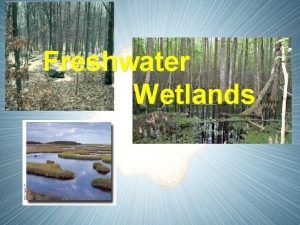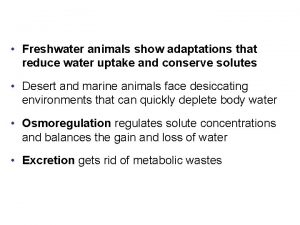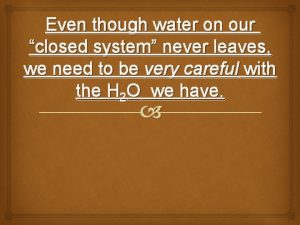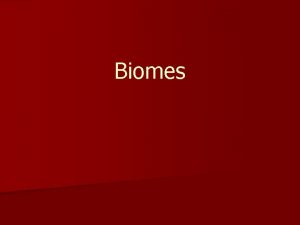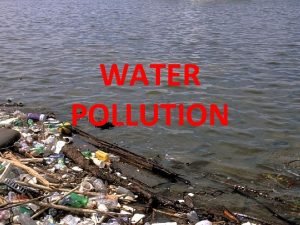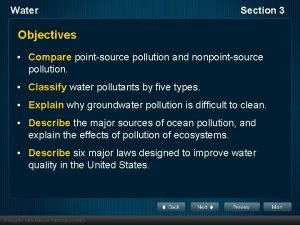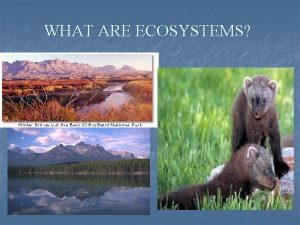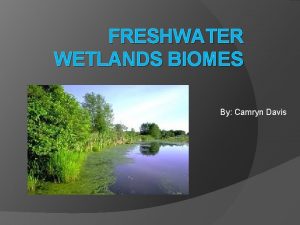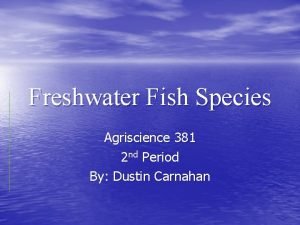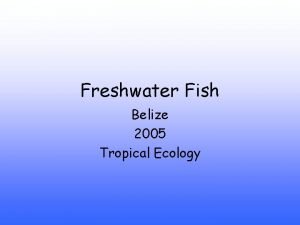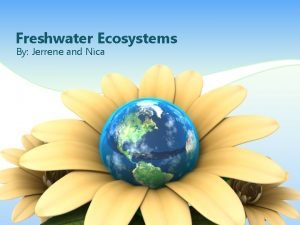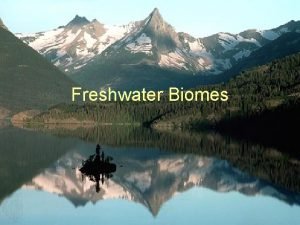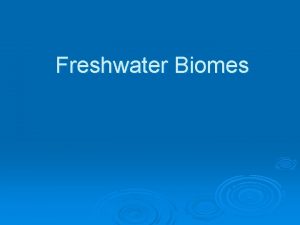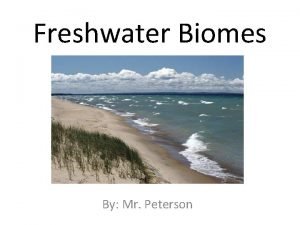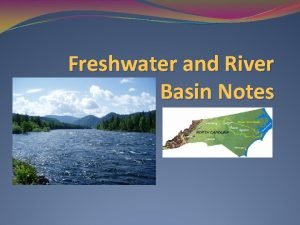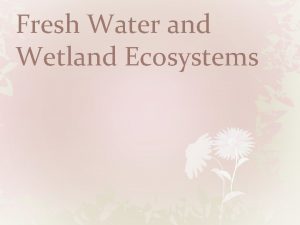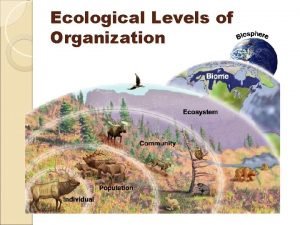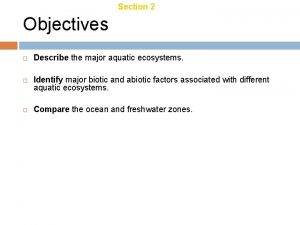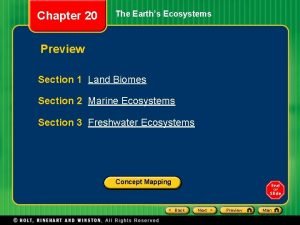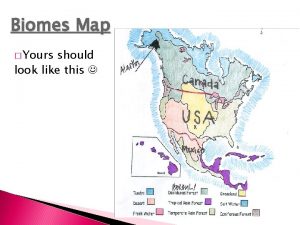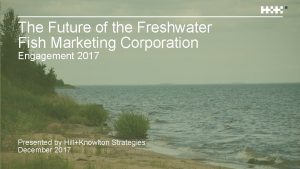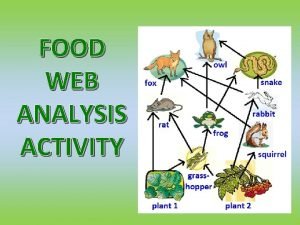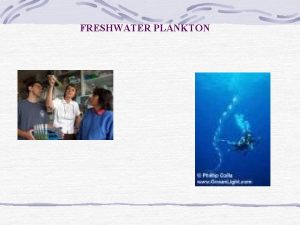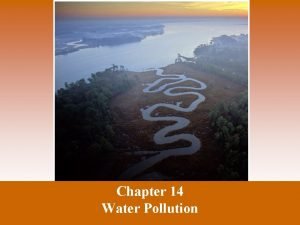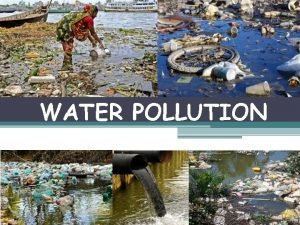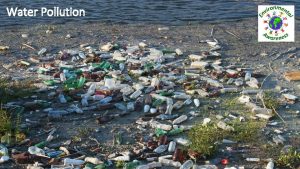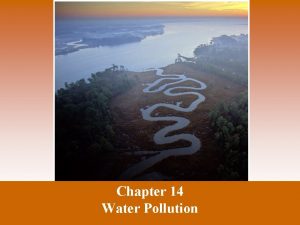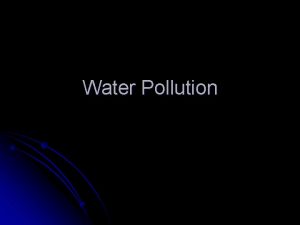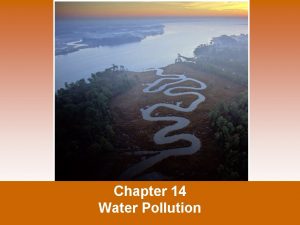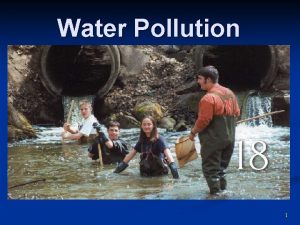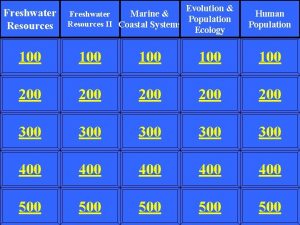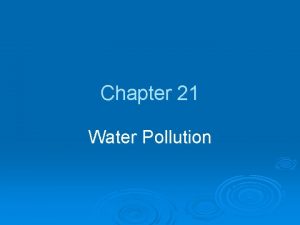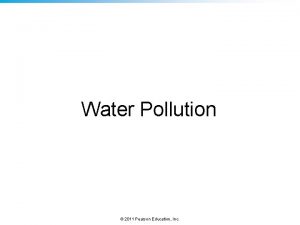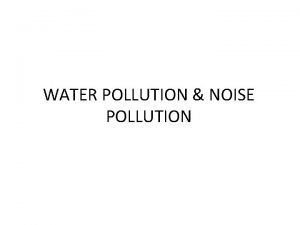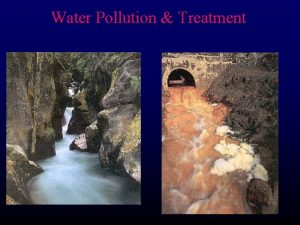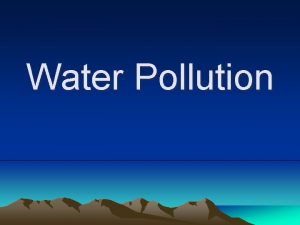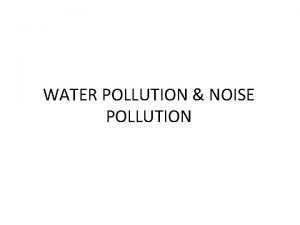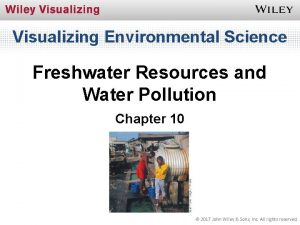Freshwater Resources and Water Pollution Properties of Water































- Slides: 31

Freshwater Resources and Water Pollution

Properties of Water § Molecules of water: H 2 O – 2 Hydrogen atoms – 1 Oxygen atom § Polar molecule – One end slightly positive – One end slightly negative

Properties of Water § Hydrogen bonds that result from water’s polarity responsible for many of water’s properties – High heat capacity (Moderates climate) – Universal solvent

The Importance of Water n n All living things need water n Composes majority of the body of organisms n Habitat for many organisms Helps regulate climate Shapes earth’s surface Dilutes & degrades wastes

Water on Earth n n n About 97% Earth’s water is salty–less than 1% of the planet’s water is available fresh H 2 O Fresh water is distributed unevenly 2025: 1/3 human population will live in areas lacking fresh water

Water, water, everywhere? (NOT) Ø Comparison of population sizes and shares of the world’s freshwater among the continents. (Only 7 countries account for 60% of global water availability)

Water Wars Ø Many countries in the Middle East, which has one of the world’s highest population growth rates, face water shortages.

Water wars cont… n n n Most water in this dry region comes from the Nile, Jordan or Tigris rivers. Countries are in disagreement as to who has water rights. Currently, there are no cooperative agreements for use of 158 of the world’s 263 water basins that are shared by two or more countries.

The Hydrologic Cycle

Surface Water n n n Streams, rivers, lakes, ponds, reservoirs, wetlands Runoff replenishes surface water Watershed n Area of land drained by a single river n What watershed do we live in?

Groundwater n n n Supply of fresh water found under Earth’s surface--recharged when water at surface infiltrates into the ground Stored in under ground aquifers Discharged into rivers, springs, etc…

Infiltration - Process of water percolating through the soil and into cracks and permeable rocks. Zone of Aeration Upper soil layers that hold both air and water. Zone of Saturation Lower soil layers where all spaces are filled with water. Water Table Top of zone of saturation

Precipitation Confined Recharge Area Flowing artesian well Infiltration Unconfined Aquifer Recharge Area Evaporation and transpiration Evaporation Runoff Well requiring a pump Water table Less permeable material such as clay Unconfined aquifer Confining permeable rock layer Recharge Zone - Area where water infiltrates into an aquifer. -Recharge rate is often very slow. -Presently, groundwater is being removed faster than it can be replenished. •

n Aquifers - Porous layers of sand, gravel, or rock lying below the water table.

Water Resource Problems n n n Too much water Too little water Poor-quality water

Changes in Surface Runoff n n Prior to 1970 about 10% of stormwater became runoff Now 55% of stormwater is transported as runoff as development exceeds 75% of the permeable soil area

Stormwater Runoff (greatest contributor to nonpoint source pollution) contains: n n n Nutrients* Metals* Suspended solids* Pesticides Hydrocarbons Microorganisms *Present in nearly 100% of stormwater samples

Too Much Water n n n Heavy rainfall, rapid snowmelt, removal of vegetation, and destruction of wetlands cause flooding. Floodplains, which usually include highly productive wetlands, help provide natural flood and erosion control, maintain high water quality, and recharge groundwater. To minimize floods, rivers have been narrowed with levees and walls, and dammed to store water.

Human activities have contributed to flood deaths and damages

Too Little Water n n Arid & semiarid lands (growing in extent -- desertification) Irrigation required to produce food n Greatest use of water (71%)

Aquifer Depletion n n Removing groundwater faster than it is replenished Lowers water table Land subsidence Saltwater intrusion n Salt water seeps into fresh water n Occurring in South Florida

Overdrawing Surface Waters n n n Damaging to ecosystems Wetlands dry up (Everglades) Estuaries become too salty (FL Bay) Worldwide, the demand for water is growing as the human population and indvidual consumption continue to grow exponentially Water wars Arial Sea

Water Management n n Goal: sustainable supply of high quality water How do we supply water? n Building dams (ex: Columbia River) n Diversion (ex: Colorado River) n Desalination (ex: FL Keys) - very expensive to build & operate plants

Water Conservation: Agriculture n n n Single largest user of water worldwide Much lost to evaporation or seepage Solution: drip irrigation n Perforated pipes distribute water n Goes straight to plants n Reduces water use 40 -60%

Water Conservation: Municipal n Solutions: n Use gray water n Education: modify habits n Water-saving fixtures & Appliances n Repair leaks n Cisterns & rain barrels n Water gardens

Water Pollution n n Physical or chemical change in water that adversely affects the health of humans or other organisms Global problem

Eutrophication n Build up of nutrients in a body of water Naturally occurs slowly Humans cause imbalances by creating pulses of nutrients due to overfertilizing crops & lawns and raising animals in confined areas Nutrients include nitrogen and phosphorus-containing compounds that are essential to life in small quantities but harmful in excess.

Sources of Water Pollution Point source: specific spot Nonpoint source n Enters over a large area n Runoff (agriculture or, urban lawns) or atmospheric deposition

Groundwater Pollution Sources

Controlling Water Pollution 1. Source Reduction (Pollution Prevention) n Cheapest and most effective way to reduce pollution is to avoid producing it or releasing it into the environment. n Design products that do not pollute n Soil Conservation 2. Ban release of pollutants 3. Reward purchasing environmentally preferable products (e. g. rebates)

The End
 Water and water and water water
Water and water and water water An ecosystem in which water either covers the soil
An ecosystem in which water either covers the soil What is transformation process
What is transformation process Variable resources examples
Variable resources examples Renewable vs nonrenewable resources worksheet
Renewable vs nonrenewable resources worksheet Freshwater animals and adaptations
Freshwater animals and adaptations Pie chart of freshwater and saltwater
Pie chart of freshwater and saltwater Limnetic zone
Limnetic zone Effects of land pollution on human health
Effects of land pollution on human health Land water and air pollution
Land water and air pollution Water pollution and unequal distribution illustration
Water pollution and unequal distribution illustration Result and conclusion of water pollution
Result and conclusion of water pollution Objectives of water pollution evs project
Objectives of water pollution evs project Water contamination introduction
Water contamination introduction Extensive and intensive properties
Extensive and intensive properties Is smell a physical property
Is smell a physical property Freshwater non living things
Freshwater non living things Wetlands biomes
Wetlands biomes Texas freshwater fish species
Texas freshwater fish species Saber toothed anchovy biome
Saber toothed anchovy biome Bibliography
Bibliography Endangered animals of north america
Endangered animals of north america Abiotic factors in freshwater biomes
Abiotic factors in freshwater biomes Freshwater biomes facts
Freshwater biomes facts Freshwater basin
Freshwater basin Description of freshwater
Description of freshwater Ecosystem foldable
Ecosystem foldable Freshwater zones diagram
Freshwater zones diagram Abiotic factors in freshwater
Abiotic factors in freshwater Map of freshwater biome
Map of freshwater biome Hill + knowlton
Hill + knowlton Freshwater food web
Freshwater food web

